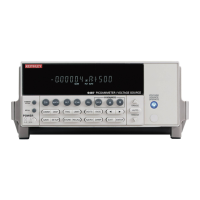Model 6487 Reference Manual Status Structure 10-19
Error queue
The error queue holds error and status messages. When an error or status event occurs, a
message that defines the error/status is placed in the error queue.
When a message is placed in the error queue, the error available (EAV) bit in the status
byte register is set. An error/status message is cleared from the error queue when it is read.
The error queue is considered cleared when it is empty. An empty error queue clears the
EAV bit in the status byte register.
The error queue holds up to 10 error/status messages. The commands to read the error
queue are listed in Table 10-7. When you read a single message in the error queue, the
“oldest” message is read and then removed from the queue. If the queue becomes full, the
message “350, ‘queue overflow’” will occupy the last memory location. On power-up, the
error queue is empty. When empty, the message “0, No Error” is placed in the queue.
Messages in the error queue are preceded by a code number. Negative (-) numbers are
used for SCPI defined messages and positive (+) numbers are used for Keithley defined
messages. The messages are listed in Appendix B. As shown in Table 10-7, there are com-
mands to read the entire message (code and message) or the code only.
On power-up, all error messages are enabled and will go into the error queue as they occur.
Status messages are not enabled and will not go into the queue. As listed in Table 10-7,
there are commands to enable and/or disable messages. For these commands, the <list>
parameter is used to specify which messages to enable or disable. The messages are speci-
fied by their codes. The following examples show various forms for using the <list>
parameter.
<list> = (-110) Single message
= (-110:-222) Range of messages (-110 through -222)
= (-110:-222, -220) Range entry and single entry (separated by a comma)
When you enable messages, messages not specified in the list are disabled. When you dis-
able messages, each listed message is removed from the enabled list.
To prevent all messages from entering the error queue, send the enable command along
with the null list parameter as follows: STATus:QUEue:ENABle ().

